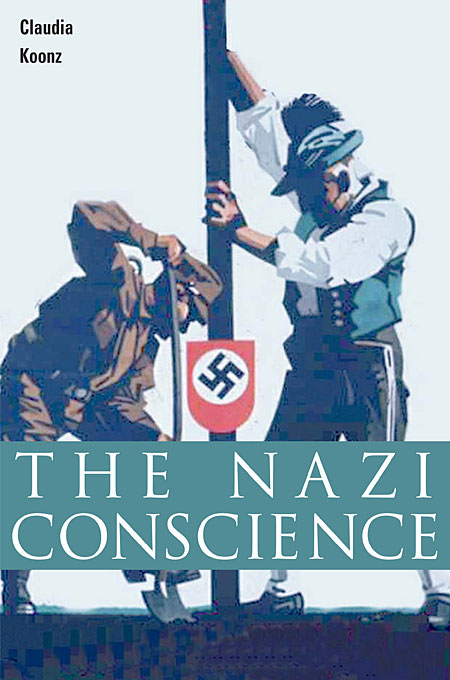
クーンズの「ナチの良心」テーゼの検討
Discussion
on Claudia Koonz'es
Nazi Conscience thesis

書籍の紹介:「『ナチスの良心』は、決して矛盾した もの(撞着語法)ではない。実際、大量虐殺の実行者たちは、民族共同体の道徳的正義を称揚し、部外者を糾弾する市民的価値観に基づいて、強力な善悪の感覚 を有していた。クラウディア・クーンズのこの著作は、第二次世界大戦前のいわゆる正常な時代に、人種的大衆化論者が(後の)大量虐殺のためのインフラと根 拠をどのように構築したかを明らかにしたものである。ナチスの膨大な人種に関する著作を丹念に読み解き、長年にわたるナチスの低俗な反ユダヤ主義が、ナチ ス党に入らなかった大多数の普通のドイツ人にとっても信用できるような人種的イデオロギーに変化していく過程を追跡している。ヒトラーに関する従来の仮説 に挑戦するクーンズは、彼のカリスマ性の源泉を、憎しみを呼び起こすことではなく、国民の集合的美徳、すなわち「ヴォルク」への訴えに求めているのであ る。1933年から1939年にかけて、ナチスの大衆文化は、クーンズが民族原理主義(ethnic fundamentalism)と呼ぶ、人種的恐怖と民族的誇りの混合物で飽和状態にあった。一般のドイツ人は、学術研究、記録映画、大衆向け雑誌、人種 衛生や芸術の展示、スライド講義、教科書、ユーモアなど、政治的とは思われないメディアで広く流布された人種的概念によって、戦時中の残虐行為に備えられ たのである。クーンズは、異質な者というレッテルを貼られた同胞ユダヤ人の迫害を日常的に受け入れることをドイツ人がいかに学んだかを示すことによって、 ホロコーストの理解に大きな貢献をした。『ナチスの良心』は、あまりにも強力な近代国家が、隣人愛や敬意、ひいては多数民族から追放されたすべての人々へ の思いやりを消滅させたという、ゾッとするような武勇伝を年代順に綴っている。」"Nielsen BookData"より
◎章立て
| Prologue | プロローグ |
|
| 1. An Ethnic Conscience | 1. 民族の良心 |
・ナチの良心に関する4つの前提(16-19) 1)フォルク(Volk)の生命は個人の生命と同じ運命をたどる 2)共同体の価値観は、与えられるものであり、その厳守が求められる 3)このましからざる住民への排除と攻撃性 4)血統の原理にもとづいて、同化国民への法的保護を永久に無効にする ・隠れた構造(ラウル・ヒルバーグ) ・市井の人たちの反ユダヤ的態度と、SS幹部のそれとは異なる。後者の動機は経済的なもの、ヒトラーにとり入ろうとするものなど。 ・ethnicc fundametalism(26) ・レーベンスラウム(27) ・知識人たち:ハイデガー、ゲルハルト・キッテル(神学者, Gerhard Kittel)、 カール・シュミット(憲法学者)  ・SA=
シュトゥルムアルプタイルング(Sturmabteilung)=突撃隊「撃
隊はナチスの前身であるドイツ労働者党(DAP)、集会の会場警備隊が改組されて創設された。初期の頃はエルンスト・レームの斡旋により義勇軍から流れて
きた者を多く受け入れたため、党からの半独立的な性格を持っていた。1923年11月のミュンヘン一揆に参加したが、失敗によって党と共に一時期禁止され
た。1925年に再建され、党に従属する組織として再出発した。党集会の警備やパレード行進の他、ドイツ社会民主党(SPD)の国旗団やドイツ共産党
(KPD)の赤色戦線戦士同盟などとの街頭闘争を行った。はじめフランツ・プフェファー・フォン・ザロモンが突撃隊最高指導者として指揮したが、党首アド
ルフ・ヒトラーとの軋轢から1930年に辞職。以降はヒトラー自らが最高指導者に就任するとともに、日常的指揮は突撃隊幕僚長に任命されたレームに委ねら
れた。1933年にナチスが政権を獲得すると、突撃隊は補助警察となり、政敵の摘発や弾圧にあたった。しかし突撃隊は失業に喘ぐ下層民が多い大衆組織で
あったため、社会主義的な思想を持つ隊員も多く、国防軍などの保守勢力との連携を深めるヒトラーにとって厄介な存在となり、1934年6月末から7月初旬
にかけてレーム以下突撃隊幹部が親衛隊(SS)によって粛清された(長いナイフの夜)。粛清後は勢力を失い、重要な役割のほとんどが親衛隊に移され、突撃
隊は国防軍入隊予定者の訓練を主任務とするようになり、第二次世界大戦の敗戦まで存続した。」 ・SA=
シュトゥルムアルプタイルング(Sturmabteilung)=突撃隊「撃
隊はナチスの前身であるドイツ労働者党(DAP)、集会の会場警備隊が改組されて創設された。初期の頃はエルンスト・レームの斡旋により義勇軍から流れて
きた者を多く受け入れたため、党からの半独立的な性格を持っていた。1923年11月のミュンヘン一揆に参加したが、失敗によって党と共に一時期禁止され
た。1925年に再建され、党に従属する組織として再出発した。党集会の警備やパレード行進の他、ドイツ社会民主党(SPD)の国旗団やドイツ共産党
(KPD)の赤色戦線戦士同盟などとの街頭闘争を行った。はじめフランツ・プフェファー・フォン・ザロモンが突撃隊最高指導者として指揮したが、党首アド
ルフ・ヒトラーとの軋轢から1930年に辞職。以降はヒトラー自らが最高指導者に就任するとともに、日常的指揮は突撃隊幕僚長に任命されたレームに委ねら
れた。1933年にナチスが政権を獲得すると、突撃隊は補助警察となり、政敵の摘発や弾圧にあたった。しかし突撃隊は失業に喘ぐ下層民が多い大衆組織で
あったため、社会主義的な思想を持つ隊員も多く、国防軍などの保守勢力との連携を深めるヒトラーにとって厄介な存在となり、1934年6月末から7月初旬
にかけてレーム以下突撃隊幹部が親衛隊(SS)によって粛清された(長いナイフの夜)。粛清後は勢力を失い、重要な役割のほとんどが親衛隊に移され、突撃
隊は国防軍入隊予定者の訓練を主任務とするようになり、第二次世界大戦の敗戦まで存続した。」 ・SS=シュッツシュタ
フェル(Schutzstaffel)=親衛隊:
「元は総統アドルフ・ヒトラーを護衛する党内組織(親衛隊)として1925年に創設された。1929年にハインリヒ・ヒムラーが親衛隊全国指導者に就任
し、彼の下で党内警察組織として急速に勢力を拡大。ナチスが政権を獲得した1933年以降には政府の警察組織との一体化が進められた。保安警察(ゲシュタ
ポと刑事警察)、秩序警察、親衛隊情報部、強制収容所など第三帝国の主要な治安組織・諜報組織はほぼ全て親衛隊の傘下に置かれていた。1934年には正規
軍である国防軍から軍事組織の保有を許可され、親衛隊特務部隊(後の武装親衛隊)を創設した。以降特務部隊以外の親衛隊員は一般親衛隊と呼ばれるように
なった。第二次世界大戦中、武装親衛隊がヨーロッパ各地で戦ったが、警察業務の親衛隊はドイツ及びドイツ占領下のヨーロッパ諸国においてナチ支配の維持、
反ナチ勢力の弾圧、ユダヤ人狩りなどにあたった。戦時中に親衛隊は絶滅収容所やアインザッツグルッペンを組織してユダヤ人の絶滅を図ろうとした(ホロコー
スト)。そのため親衛隊は悪名高い組織となり、戦後のニュルンベルク裁判では全ての親衛隊組織は「犯罪組織(英:Criminal
Organization)」であるとする認定を受けた。21世紀に入って尚、隊員達は本人の死亡が確認されるまで犯罪者として追跡され、居所が確認され
れば逮捕、裁判に掛けられている[1]。隊のモットーは「Meine Ehre heißt Treue(My honor is called
fidelity:忠誠こそ我が名誉、我が名誉は忠誠を宣する事)」。」 ・SS=シュッツシュタ
フェル(Schutzstaffel)=親衛隊:
「元は総統アドルフ・ヒトラーを護衛する党内組織(親衛隊)として1925年に創設された。1929年にハインリヒ・ヒムラーが親衛隊全国指導者に就任
し、彼の下で党内警察組織として急速に勢力を拡大。ナチスが政権を獲得した1933年以降には政府の警察組織との一体化が進められた。保安警察(ゲシュタ
ポと刑事警察)、秩序警察、親衛隊情報部、強制収容所など第三帝国の主要な治安組織・諜報組織はほぼ全て親衛隊の傘下に置かれていた。1934年には正規
軍である国防軍から軍事組織の保有を許可され、親衛隊特務部隊(後の武装親衛隊)を創設した。以降特務部隊以外の親衛隊員は一般親衛隊と呼ばれるように
なった。第二次世界大戦中、武装親衛隊がヨーロッパ各地で戦ったが、警察業務の親衛隊はドイツ及びドイツ占領下のヨーロッパ諸国においてナチ支配の維持、
反ナチ勢力の弾圧、ユダヤ人狩りなどにあたった。戦時中に親衛隊は絶滅収容所やアインザッツグルッペンを組織してユダヤ人の絶滅を図ろうとした(ホロコー
スト)。そのため親衛隊は悪名高い組織となり、戦後のニュルンベルク裁判では全ての親衛隊組織は「犯罪組織(英:Criminal
Organization)」であるとする認定を受けた。21世紀に入って尚、隊員達は本人の死亡が確認されるまで犯罪者として追跡され、居所が確認され
れば逮捕、裁判に掛けられている[1]。隊のモットーは「Meine Ehre heißt Treue(My honor is called
fidelity:忠誠こそ我が名誉、我が名誉は忠誠を宣する事)」。」・最終解決(→ヴァンゼー会議)——は、突如としてあらわれたのではな く、1933-1939年のポーランド進行の準備以降のなかで、皆殺しのコンセンサスが形成された。 |
| 2. The Politics of Virtue | 2. 美徳の政治学 |
・ユダヤ人を政治的敵と表現するよりも、悪疾としての病気や病原菌とし
て表現される。 ・ヒトラーの演説の写真練習(写真家ハインリヒ・ホフマン) ・フォルク(Volk)あるいはフェルキッシュ(völkisch) |
| 3. Allies in the Academy | 3. アカデミーの中の同盟者 |
|
| 4. The Conquest of Political Culture | 4. 政治文化の征服 |
|
| 5. Ethnic Revival and Racist Anxiety | 5. 民族復興と人種主義的不安 |
|
| 6. The Swastika in the Heart of the Youth | 6. 若者の心の中の鉤十字 |
|
| 7. Law and the Racial Order | 7. 法律と人種秩序 |
|
| 8. The Quest for a Respectable Racism | 8. 尊敬される人種主義の探求 |
|
| 9. Racial Warriors | 9. レイシズムの戦士たち |
|
| 10. Racial War at Home | 10. 家庭での人種戦争 |
|
| Abbreviations | 略記号 |
|
| Notes | 備考・脚注 |
|
| Acknowledgments | 謝辞 |
|
| Illustration, Credits, Index | 図版、クレジット、索引 |
Claudia Koonzについて
| Claudia Ann Koonz
is
an American historian of Nazi Germany. Koonz's critique of the role of
women during the Nazi era, from a feminist perspective, has become a
subject of much debate and research in itself.[1][2] She is a recipient
of the PEN New England Award, and a National Book Award finalist.[3][4]
Koonz has appeared on the podcasts Holocaust, hosted by University of
California Television,[5] and Real Dictators, hosted by Paul McGann.[6]
In the months before the 2020 United States presidential election,
Koonz wrote about the risks of autocracy in the United States for
History News Network[7][8] and the New School's Public Seminar.[9] |
クラウディア・アン・クーンズは、アメリカのナチス・ドイツの歴史家で
ある。フェミニストの視点からナチス時代の女性の役割を批判し、それ自体が多くの議論や研究の対象となっている[1][2]。
PENニューイングランド賞の受賞者であり、全米図書賞の最終候補者である[3][4]。 [3][4]
クーンズはカリフォルニア大学テレビが主催するポッドキャストHolocaust[5]とポール・マクガンが主催するReal
Dictatorsに出演している[6] 2020年の米国大統領選挙前の数ヶ月、クーンズはHistory News Network[7][8]
とニュースクールのパブリックセミナーで米国における独裁政治の危険性について書いている[9]。 |
| Koonz received a BA in 1962 from
the University of Wisconsin, Madison that included two semesters
studying at the University of Munich. After a year of traveling
overland through Asia,[10] she studied at Columbia University, from
which she earned an MA in 1964, before earning a PhD from Rutgers
University in 1969.[11] |
クーンズは、1962年にウィスコンシン大学マディソン校で学士号を取
得し、ミュンヘン大学に2学期留学した。1年間アジアを陸路で旅した後、コロンビア大学に留学し、1964年に修士号を取得、1969年にラトガース大学
で博士号を取得した[11]。 |
| Claudia Koonz is Peabody Family
Professor emerita in the History Department at Duke University. Before
coming to Duke in 1988, she taught at College of the Holy Cross in
Worcester, Massachusetts,[10] and at Long Island University,
Southampton from 1969 to 1971. Together with Renate Bridenthal, she edited the first anthology of European women’s history, Becoming Visible.[12] She subsequently published two books, Mothers in the Fatherland: Women, the Family and Nazi Politics and The Nazi Conscience, which analyze the sources of ordinary Germans' support for the Nazi Party during Weimar and Nazi Germany.[10] The Nazi Conscience has been translated into Spanish, Japanese, and Russian.[13] Her current book on stereotypes in French media (forthcoming with Duke University Press) is Between Foreign and French: Prominent French Women from Muslim Backgrounds in the Media Spotlight, 1989-2020.[13] |
クラウディア・クーンズはデューク大学歴史学部のピーボディ・ファミ
リー名誉教授。1988年にデューク大学に来る前は、マサチューセッツ州ウースターのカレッジ・オブ・ザ・ホリー・クロスで教え[10]、1969年から
1971年まではロングアイランド大学サザンプトン校で教えていた。 レナーテ・ブリデンタールとともに、ヨーロッパ女性史の最初のアンソロジーである『Becoming Visible』を編集した[12]。The Nazi Conscienceは、スペイン語、日本語、ロシア語に翻訳されている[10]。フランスのメディアにおけるステレオタイプに関する現在の著書(デュー ク大学出版から近刊)は、Between Foreign and French。Between Foreign and French: Prominent French Women from Muslim Backgrounds in the Media Spotlight, 1989-2020』である[13]。 |
| Mothers in the Fatherland Koonz is best known for documenting the appeal of Nazism to German women and understanding their enthusiasm for the Nazis. Koonz has established that the leaders of German feminist, civic, and religious groups acquiesced to Nazification (Gleichschaltung) that coerced Germans into following Nazi policy. Women in Marxist movements joined with men in operating underground opposition networks. Koonz has noted that female supporters of the Nazis accepted the Nazi division of the sexes into a public sphere for men and a private sphere for women. A reviewer in the New York Times wrote that Mothers in the Fatherland explored the “paradox that the very women who were so protective of their children, so warm, nurturing and giving to their families, could at the same time display extraordinary cruelty.”[14] Koonz has claimed that women involved in resistance activities were more likely to escape notice owing to the "masculine" values of the Third Reich.[15] A mother, for example, could smuggle illegal leaflets through a checkpoint in a pram without arousing suspicion. Koonz is also known for her claim that two kinds of women asserted themselves in the Third Reich: those, like Gertrud Scholtz-Klink, who gained power over women under their supervision in exchange for subservience to the men who wielded power over them (the authoritarian trade off) and the women who violated the norms of civilized society, such as camp guards like Ilse Koch. Koonz includes women who were opposed to Nazism 100% as well as "single issue" critics (of, for example, sterilization and euthanasia) but did not protect or protest the deportation of Jews to death camps. Koonz's views have often been pitted against those of Gisela Bock in a battle some have referred to as the Historikerinnenstreit (quarrel among historians of women).[2][16][17][18] Mothers in the Fatherland integrates archival research into an exploration of “the nature of feminist commitment, complicity in the Holocaust, and the meaning of Germany’s past.”[19][20] The Nazis promised “emancipation from emancipation,” an appeal that resonated with Germans who feared that male-female equality meant “social and family disintegration.” But Koonz highlights the paradoxes produced by the Third Reich’s dependence on women’s participation (as subordinates, to be sure) in child-bearing, social work, education, surveillance, health care, and compliance with race policy. A reviewer in the New York Times wrote that Koonz dug “deeply and discerningly into a variety of documents,... to record the mixed results of Nazi efforts at mobilizing women’s groups, secular, Protestant and Catholic” and Jewish women’s efforts to fight against confiscation, ostracism, deportation and murder.[21] Catherine Stimpson called the contradictory message of Mothers of the Fatherland “painful” because: “If many societies deprive women of power over themselves, women still have power to exercise. Women, though Other to men, have their Others too. In the United States white women did own black slaves of both sexes, and in Nazi Germany, as Claudia Koonz showed us in her heartbreaking book, Mothers in the Fatherland, Nazi women did brutalize and kill Jews of both sexes. And colonizers both lorded and ladied it over the colonized of both sexes.”[22] |
祖国の母たち クーンズは、ドイツ人女性にとってのナチズムの魅力を記録し、彼女たちのナチスへの熱意を理解したことで最もよく知られている。クーンズは、ドイツのフェ ミニスト、市民、宗教団体の指導者たちが、ドイツ人をナチスの政策に従うように強制するナチス化(Gleichschaltung)を容認していたことを 立証している。マルクス主義運動の女性たちは、男性とともに地下の反対ネットワークを運営していた。クーンズは、ナチスの女性支持者たちが、ナチスの「男 は公的領域、女は私的領域」という性別の分断を受け入れていたことを指摘している。ニューヨーク・タイムズ』紙の批評家は、『祖国の母たち』について、 「子供をとても守り、温かく育て、家族に与える女性たちが、同時に並外れた残虐性を示すことができるというパラドックス」を探求したと書いている [14]。 クーンズは、抵抗活動に関わる女性は、第三帝国の「男性的」価値観により、気づかれないようにする傾向が強かったと主張している。 例えば、母親なら違法ビラを疑われずにベビーカーのままで検問所を密輸することができたとするものである[15]。 ゲルトルート・ショルツ=クリンクのように、権力を振るう男性に服従する代わりに、自分の監督下にある女性に対する権力を得る女性(権威主義のトレードオ フ)、イルゼ・コッホのような収容所看守のように文明社会の規範を侵害する女性である。クーンツには、ナチズムに100%反対した女性や、(例えば不妊手 術や安楽死などの)「単一問題」批判者でありながら、ユダヤ人の死の収容所への強制送還を保護も抗議もしなかった女性も含まれている。クーンツの見解はし ばしばギゼラ・ボックの見解と対立し、「女性史研究者の喧嘩」と呼ばれることもある[2][16][17][18]。 祖国の母たち』は、「フェミニストのコミットメントの性質、ホロコーストへの加担、ドイツの過去の意味」の探求にアーカイブズ研究を統合している[19] [20]。ナチは「解放からの解放」を約束し、その訴えは、男女平等が「社会と家族の崩壊」を意味すると恐れるドイツ人に共鳴するものだった。しかし、 クーンズは、第三帝国が出産、社会事業、教育、監視、医療、人種政策の遵守に女性の参加(確かに部下として)に依存したことによって生じた逆説を強調して いる。ニューヨーク・タイムズ紙の批評家は、クーンズが「様々な文書を深く見分けながら、...ナチスの女性グループ、世俗、プロテスタント、カトリック を動員する努力の混合した結果を記録するために」、ユダヤ人女性が没収、追放、国外追放、殺人と戦う努力をしたと書いている[21]。 キャサリン・スティンプソンは『祖国の母たち』の矛盾したメッセージを「痛々しい」と述べている。 「多くの社会が女性から自分に対する力を奪っていたとしても、女性には行使する力がある。女性は男性にとって他者であるが、他者も持っている。アメリカで は白人女性が男女を問わず黒人奴隷を支配した。ナチス・ドイツでは、クラウディア・クーンズがその悲痛な著書『祖国の母たち』で示したように、ナチスの女 性は男女を問わずユダヤ人を残虐に殺害したのだ。そして、植民地化者は、男女を問わず、植民地化された者に対して、威張り散らし、淑やかに振る舞った」 [22]。 |
| The Nazi Conscience Conventional scholarship defines Nazism by its anti-Semitism, anti-modernism, and anti-liberalism, as expressed in publications like Der Stürmer, but The Nazi Conscience examines the “positive” values of community and ethnic purity that attracted ordinary Germans, including millions who had never voted Nazi before Adolf Hitler's takeover. A reviewer wrote that Koonz’s book challenges us to “suspend temporarily our understanding of Nazism and to try to understand the movement as the Nazis themselves understood it. In doing so, we can better understand how murderous racist doctrines infiltrated the moral and psychological fabric of the German people so easily.”[23] A reviewer for The Review of Politics called The Nazi Conscience a “meticulously researched and engrossingly written book”.[24] Another reviewer called it a "tour de force" that documents the formation of a consensus that evolved during the “normal” years of the Third Reich, 1933-1941.[25] This was a time when National Socialist racial policy congealed, or according to Koonz, “metastasized” in three contexts: Hitler’s public persona, academic think tanks, and bureaucratic networks.[26] During these years, the rabidly anti-Semitic Nazi base was held in check by Hitler himself and the proponents of a “rational” assault against Jews. Although ordinary Germans deplored violence, anti-Semitic measures that appeared “legal” were scarcely noticed.[27] After all, fewer than one percent of all Germans were Jewish, and by 1939 half of them had emigrated. Besides, Hitler’s government ended unemployment, scored diplomatic victories, and revived national pride. Most citizens “accepted a new Nazi-specific morality that was steeped in the language of ethnic superiority, love of fatherland, and community values," according to another review of The Nazi Conscience.[28] Koonz cautioned that nostalgia for imagined glory is a potent force that could rally aggrieved citizens to ethnic nationalism elsewhere. “In examining how National Socialism mobilized diverse but quotidian institutional contexts to create a ‘community of moral obligation,’ she invites us to reflect on . . . the ways contemporary society demonizes, ostracizes, and excludes certain classes of people."[24] Corey Robin noted Koonz “might have cited Thomas Jefferson who, anticipating the Nazis by more than a century, saw no future for freed blacks other than deportation or extermination.”[29] |
ナチスの良心 従来の学問では、ナチズムは反ユダヤ主義、反近代主義、反リベラリズムによって定義され、それは『シュトゥルマー』などの出版物に表現されていたが、『ナ チの良心』は、共同体と民族の純粋性という「肯定的」価値によって、普通のドイツ人、それもアドルフ・ヒトラーの支配以前に一度もナチに投票しなかった数 百万人を魅了したことについて考察している。 ある書評家は、クーンズの本は、「ナチズムに対する理解を一時中断し、ナチス自身が理解したように、この運動を理解しようとする」ことに挑戦していると書 いている。そうすることで、殺人的な人種差別の教義がどのようにドイツ国民の道徳的、心理的構造にいとも簡単に浸透していったかをよりよく理解することが できる」[23]。 The Review of Politicsの批評家はThe Nazi Conscienceを「綿密に研究され、夢中になって書かれた本」と呼んでいる[24] 別の批評家は第三帝国の「通常」の時代である1933年から1941年の間に発展した合意の形成を記録した「力作」と呼んでいる[25] この時代は国家社会主義の人種政策が三つの文脈において凝集し、クーンツによれば「転移」していた時期であった。ヒトラーの公的な人格、学術的なシンクタ ンク、そして官僚的なネットワークである[26]。 この時期、狂信的な反ユダヤ主義の基盤は、ヒトラー自身とユダヤ人に対する「合理的」な攻撃の支持者たちによって抑制されることになった。普通のドイツ人 は暴力を嘆いたが、「合法的」に見える反ユダヤ的措置はほとんど注目されなかった[27]。 結局、ドイツ人全体の1パーセント未満しかユダヤ人はおらず、1939年までにその半数が移住していた。その上、ヒトラー政権は失業をなくし、外交的勝利 を収め、国民の誇りを復活させた。ナチの良心』の別の書評によれば、ほとんどの国民は「民族的優越性、祖国愛、共同体の価値という言葉に彩られた新しいナ チ特有の道徳を受け入れた」[28]。 クーンズは、想像上の栄光へのノスタルジアは、不満を抱えた市民を別の場所で民族ナショナリズムに結集させる可能性のある強力な力であると警告している。 国家社会主義がどのように多様だがありふれた制度的文脈を動員して「道徳的義務の共同体」を作り上げたかを検討する中で、彼女は現代社会が特定の階級の人 々を悪魔化し、追放し、排除する方法について考察するよう私たちを誘う」[24] [Corey Robinはクーンズが「ナチを1世紀以上先取りして、追放か絶滅以外に解放黒人の未来を見ていないトーマス・ジェファーソンのことを引用したかもしれな い」[29]と指摘している。 |
| Prior
to the 2020 United States presidential election, Koonz published
articles in History News Network and the New School's Public Seminar
warning about the risks of autocracy in the United States.[7][8][9]
Following the election of Joe Biden in 2020, Koonz's work analyzed the
presidency of Donald Trump through the lens of World War II
history,[30] and analyzed the withdrawal of United States troops from
Afghanistan in 2021 through a historical lens.[31] |
2020
年のアメリカ合衆国大統領選挙に先立ち、クーンズはHistory News NetworkとニュースクールのPublic
Seminarでアメリカにおける独裁政治のリスクについて警告する記事を発表した[7][8][9]。
2020年のジョー・バイデンの当選後、クーンズはドナルド・トランプの大統領就任を第二次世界大戦史のレンズを通して分析し[30]、2021年のアメ
リカ軍のアフガン撤退を歴史レンズで分析した[31]。 |
| Awards and honors 1987 National Book Award non-fiction finalist[3] 1987 New York Times Notable Book of 1987[32] 1987 Outstanding Book in Women's History at the Berkshire Conference of Women Historians[33] 1987 PEN-Boston Globe Winship Book of the Year Award 1990 Libération (Paris) best 100 books of 1990[11] 1990-1991 Raoul Wallenberg Visiting Professorship, Rutgers University, Rutgers Institute for History 1993-1994 National Humanities Center Fellowship[34] 1993-1994 American Council of Learned Societies Fellowship[35] 2005-2006 John Simon Guggenheim Foundation[36] 2006 American Academy in Berlin Haniel Fellow[11] 2007 Duke University Distinguished Teaching Award[37] |
受賞歴と栄誉 1987年 全米図書賞ノンフィクション部門最終候補[3] 1987年 ニューヨーク・タイムズ紙「1987年注目すべき書籍」[32] 1987年 バークシャー女性歴史家会議「女性史分野における傑出した書籍」[33] 1987年 PEN-ボストン・グローブ・ウィンシップ年間最優秀図書賞 1990年 リベラシオン(パリ)1990年ベスト100書籍[11] 1990-1991年 ラウル・ワレンバーグ客員教授職、ラトガース大学歴史研究所 1993-1994年 国立人文科学センターフェローシップ[34] 1993-1994年 アメリカ学術協会連合フェローシップ[35] 2005-2006年 ジョン・サイモン・グッゲンハイム財団[36] 2006年 ベルリン・アメリカン・アカデミー ハニエル・フェロー[11] 2007年 デューク大学 優秀教育賞[37] |
| Work co-edited with Renate Bridenthal Becoming Visible: Women in European History, 1977, revised edition 1987. Mothers in the Fatherland: Women, the Family, and Nazi Politics, 1986[38] The Nazi Conscience Cambridge, Massachusetts: The Belknap Press of Harvard University Press, 2003, ISBN 978-0-674-01172-4. |
著作 レナーテ・ブリデンタールとの共編著『可視化される存在:ヨーロッパ史における女性』1977年、改訂版1987年。 『祖国の母たち:女性、家族、そしてナチス政治』1986年[38] 『ナチスの良心』マサチューセッツ州ケンブリッジ:ハーバード大学出版局ベルナップ・プレス、2003年、ISBN 978-0-674-01172-4。 |
| https://en.wikipedia.org/wiki/Claudia_Koonz. |
1881年のユダヤ人の人口比をしめすマップ
●『父の国の母たち : 女を軸にナチズムを読む』
「人種と性についての二つの「革命」を行ったナチ・
ドイツ。この革命を遂行するには、“二流の性”としての女性の参加が不可欠だった—男性指導者の神話に隠れ、これまで語られなかった女たち。体制協力者・
キリスト教徒・抵抗者・ユダヤ女性の役割と選択を通じて、あらたな角度からナチズムを読む。「価値ある者」と「価値のない者」を分割した「父の国=ナチ・
ドイツ」では、“家族”に対する幻想が大きな意味を持つことになった。「家族の守り手=母」である女たちは、この社会のなかで何を願い、どのように生きた
のか。父性と母性の対立を手がかりに、個人と国家の本質的な関係を探る」"BOOK database").
●虐殺(genocide)のタイポロジー:ナチスドイツ時代における虐殺遂行の四分類
| 虐殺のタイプ |
論者 |
殺害への関与 |
| 普通の人が別人格になり銃を乱射するタイプ | クリストファー・ブラウニング |
「普通の人」という用語はブラウニングの書名より由来する。最初は躊躇
しても、次第に無感覚になり虐殺に加担するようになる。なかには精神的に耐え切れずにアルコールに頼りながら虐殺行為を続ける兵士もいた。 |
| 隣人だったひとがユダヤ人を殺害するタイプ |
ヤ
ン・グロス |
ポーランドでは、ユダヤ人との混住が可能であったのに、ナチス侵攻以
降、積極的に元友人たちを殺害するようになる。ルワンダでのツチに対するフツの虐殺行為も類似(→ルワ
ンダでの出来事)。 |
| 犠牲者になる人たちが加害者と一緒になって虐殺に加担するタイプ |
プリモ・レーヴィ、クロード・ランズマン |
絶滅収容所において、ユダヤ人収容者からリクルートされた特別労務班
(ゾンダーコマンド)のメンバーになり、ナチス将校から指示を受けて、実際の虐殺労務に携わる。 |
| 机上の殺害者 |
ハンナ・
アーレント |
アドルフ・アイヒマンのように収容所システムの官僚として働き、カントの定
言命法すら理解しながらも、虐殺を知りながら自分の目の前に与えられた業務を粛々と遂行する。 |
+++
リンク
文献
その他の情報



++
Copyleft,
CC, Mitzub'ixi Quq Chi'j, 1996-2099